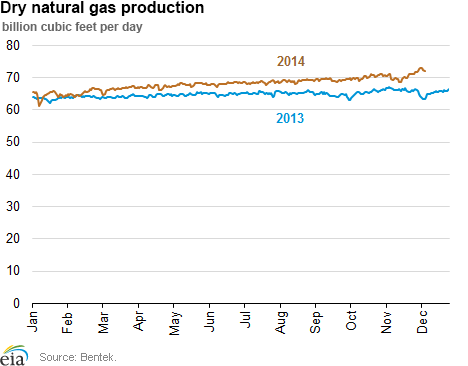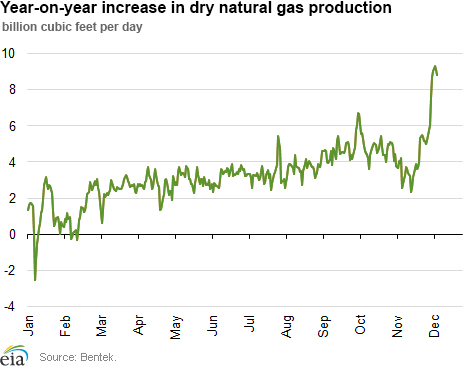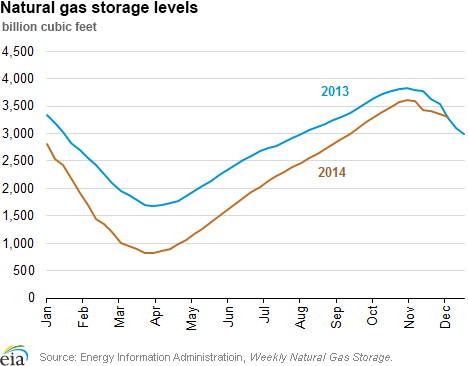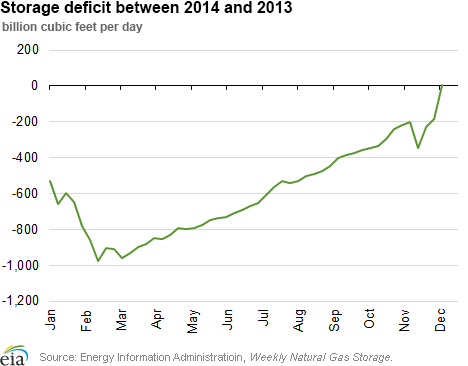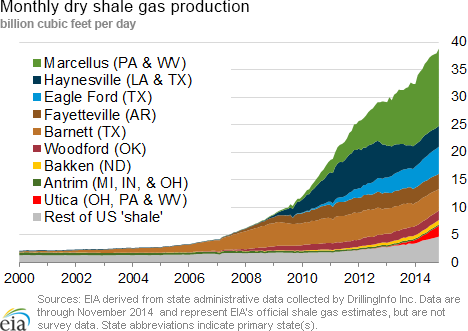In the News:
Natural gas storage exceed year-ago levels, and production is higher
According to this morning's EIA Weekly Natural Gas Storage Report, natural gas storage levels for the Lower 48 states, as of December 12, are slightly above 2013 levels for the first time this year. Inventories totaled 3,295 billion cubic feet (Bcf) as of December 12, compared to 3,289 Bcf in the same week of 2013. Stock levels fell sharply in early 2014 because of extremely cold weather, and remained at or below the five-year minimum level up until this week.
Despite concerns raised about the storage deficit going into the 2014-15 heating season, the year-over-year gap in inventories has been continually falling since April, when it was nearly 1,000 Bcf. Storage levels are still 258 Bcf lower than the five-year (2009 – 13) average, but this gap has also narrowed substantially since April.
At the start of the heating season, the storage deficit was 238 Bcf, but a combination of strong year-over-year production growth, and relatively moderate temperatures compared to last winter, has helped erase this deficit. From November 1, 2014 through this most recent storage report (December 12), storage withdrawals averaged 6.1 Bcf per day (Bcf/d), compared to 12.4 Bcf/d over the same period in 2013.
In the past several weeks, natural gas production levels have risen to record highs, according to production data from Bentek Energy, LLC. Dry natural gas production averaged 70.8 Bcf/d since November 1, which is an increase of 4.8 Bcf/d over that same period in 2013, according to Bentek. A contributing factor to lower production levels in 2013 was production freeze-offs that occurred in December 2013. In the current Short-Term Energy Outlook (STEO), EIA forecast that production will continue to increase through 2015.
According to Bentek data, consumption has averaged 78.1 Bcf/d since November 1, 2014, compared to 83.0 Bcf/d over the same time period last year. More moderate temperatures in 2014 are supporting the decrease in consumption; heating degree days since the start of November have been 7.2% lower in 2014 compared to 2013. EIA forecasts that natural gas consumption for the remaining months of the winter will be much lower than last year's historically cold winter, driven by closer-to-average NOAA temperature forecasts from the National Oceanic and Atmospheric Administration (NOAA). Since the start of November, production has levels were 91.3% of consumption on average. This percentage is higher than last year, when production accounted for 79.4% of consumption. Lower net imports are also contributing to the increasing share of consumption being satisfied by domestic production.
EIA forecasts that inventories at the end of March 2015 will be 1,431 Bcf, significantly higher than the 2014 end-of-March inventories, which were at an 11-year low of 857 Bcf. However, even if the rest of the winter matches last winter in severity, it is unlikely that storage inventories would drop as low as they did at the end of last winter because of the gains in production.
Overview:
(For the Week Ending Wednesday, December 17, 2014)
- With average to above average temperatures through most of the week, spot prices at most trading locations fluctuated slightly around their weekly starting point before ending the report week (Wednesday to Wednesday) modestly higher due to colder temperatures at the end of the week. The exception occurred in trading locations in the Mid-Atlantic and Northeast regions, where prices fell with more temperate weather this week following last week's cold temperatures and storms. Henry Hub spot price started the report week at $3.61 per million British thermal units (MMBtu) last Wednesday, December 10, and ended at $3.65/MMBtu yesterday, December 17.
- At the New York Mercantile Exchange (Nymex), the January 2015 contract began the report week at $3.706/MMBtu, rising and falling by less than 10 cents through the course of the week, and ending the week at $3.702/MMBtu.
- Working natural gas in storage decreased to 3,295 Bcf as of Friday, December 12, according to the U.S. Energy Information Administration (EIA) Weekly Natural Gas Storage Report (WNGSR). A net withdrawal from storage of 64 Bcf for the week resulted in storage levels 0.2% above year-ago levels and 7.3% below the five-year average for this week.
- The total U.S. rotary rig count for the week ending December 12 decreased by 27 units to 1,893 rigs, according to data from Baker Hughes Inc. The natural gas rig count increased by 2 units to 346, while oil rigs decreased by 29 units to 1,546. One miscellaneous rig remained in service.
- The Mont Belvieu natural gas plant liquids composite price fell by 15.3% to $5.50/MMBtu for the week ending December 12. All component prices fell this week; prices declined as follows: natural gasoline -12.6%, ethane -4.0%, propane -19.7%, butane -17.7% and isobutane by -17.4%.
Prices/Demand/Supply:
At most market locations outside of the Northeast, prices rise slightly. Natural gas prices at most market locations had limited daily movements during the week, showing only modest increases Wednesday-to-Wednesday. The small price movements were largely the result of temperatures in most regions that were near or above normal for most of the report week. With colder temperatures at the end of the week, as well as forecasts for continued seasonal weather, prices closed the week higher Wednesday-to-Wednesday. The price at the Henry Hub in Louisiana started the week at $3.61/MMBtu, then after fluctuating slightly throughout the week, closed the week yesterday at $3.65/MMBtu.
Northeast spot prices drop through the week. Due to colder weather and continued system maintenance at the start of the report week, prices at Algonquin Citygate (serving Boston), and Tennessee Zone 6 200L (Connecticut/New England) were elevated last Wednesday at just under $10/MMBtu. As temperatures moderated and maintenance was completed, prices at these locations fell through the week by approximately 50%, closing yesterday at $5.02/MMBtu and $4.82/MMBtu respectively. Prices at Transco Zone 6 NY (servicing New York City), also decreased after starting the week at an elevated level, falling 17% Wednesday-to-Wednesday.
Marcellus-area prices decrease during the week. Three of the most active trading points for Marcellus/Utica production all closed down for the week ending December 17. Prices at Tennessee's Zone 4 Marcellus and Transcontinental's Leidy Line trading point, both started the week slightly over $2/MMBtu, but fell to end the week slightly under $2/MMBtu. Prices at Dominion South, started the report week just under $3/MMBtu, and fell over 50 cents by yesterday's close.
Nymex January contract price ends the report week flat. The January futures contract price oscillated up and down during the trading week by more than 10 cents, ending the report week within 1 cent of its starting price to close yesterday at $3.702/MMBtu. The 12-month strip, the average of January 2015 through December 2015 futures contracts, ended the week down 3 cents, at $3.556/MMBtu.
U.S. Dry gas production continues to rise during the report week. Dry gas production, as reported by Bentek Energy, remained strong, with single days during the report week exceeding 73 billion cubic feet per day (Bcf/d) and a weekly average above 72.5 Bcf/d. Production gains occurred in the Northeast and Southeast, with some production declines noted in Texas and the Rockies. Imports of natural gas from Canada decreased by 1.7% this week as temperatures returned to near or above normal throughout the United States. LNG sendout remained minimal.
Demand decreases as temperatures moderated nationally. U.S. demand for natural gas fell by 0.6% as weather conditions improved for the report week and temperatures returned to near or above normal. The only sector showing an increase for the week was the residential/commercial sector, which logged 0.3% week-over-week growth. Consumption of natural gas used for electrical power generation (power burn) decreased 1.9%, despite a 9.6% increase in power burn in the Southeast (the largest consuming power burn region). In addition to colder weather at the start of the report week in the Southeast, the Joseph M. Farley nuclear power plant in Alabama, which was off line for some of this report week, may account for part of the increased demand for natural gas in that region. This plant came back online on Tuesday. U.S. exports of natural gas to Mexico decreased by 14% for the report week (Wednesday-to-Wednesday).
Storage
Net withdrawal is lower than the five-year average and last year's withdrawal. The net withdrawal reported for the week ending December 12 was 64 Bcf, 93 Bcf lower than the five-year average net withdrawal for that week of 157 Bcf and 192 Bcf lower than last year's net withdrawal of 256 Bcf. Working gas inventories as of December 12 totaled 3,295 Bcf, 6 Bcf (0.2%) higher than last year at this time and 258 Bcf (7.3%) lower than the five-year (2009-13) average. This was the first time this year that working gas inventories this year exceeded last year's values.
Storage withdrawals are smaller than market expectations. Market expectations called for an average pull of 60 Bcf. When the EIA storage report was released at 10:30 a.m. on December 18, the price for the January natural gas futures contract rose 3 cents to $3.79/MMBtu in trading on the Nymex, but quickly fell to $3.74 a few minutes later.
East and West regions are now above their year ago levels. The East and Producing regions had net withdrawals of 55 Bcf (29 Bcf lower than its five-year average withdrawal) and 10 Bcf (38 Bcf lower than its five-year average withdrawal), respectively. The West region had a net injection of 1 Bcf (compared with its five-year average withdrawal of 25 Bcf). Storage levels for all three regions remain below their five-year average levels, but for the East and West regions, storage levels were above their year ago level by 23 Bcf and 13 Bcf, respectively.
Temperatures during the storage report week are warmer than normal. Temperatures in the Lower 48 states averaged 41.9° for the storage report week, 3.3°warmer than the 30-year normal temperature and 10.6° warmer than the temperatures during the same week last year. There were 164 population-weighted heating degree days during the storage report week, 23 fewer than the 30-year normal temperature and 76 fewer than during the same period last year.
See also:
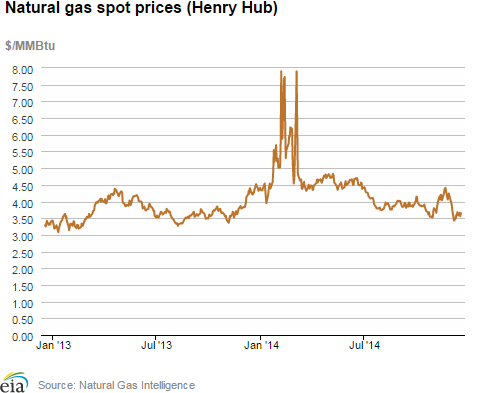
| Spot Prices ($/MMBtu) | Thu, 11-Dec |
Fri, 12-Dec |
Mon, 15-Dec |
Tue, 16-Dec |
Wed, 17-Dec |
|---|---|---|---|---|---|
| Henry Hub |
3.68 |
3.58 |
3.66 |
3.56 |
3.65 |
| New York |
3.75 |
3.69 |
3.72 |
3.60 |
3.72 |
| Chicago |
3.61 |
3.61 |
3.75 |
3.71 |
3.81 |
| Cal. Comp. Avg,* |
3.73 |
3.70 |
3.85 |
3.75 |
3.82 |
| Futures ($/MMBtu) | |||||
| January Contract |
3.634 |
3.795 |
3.719 |
3.619 |
3.702 |
| February Contract |
3.663 |
3.816 |
3.730 |
3.635 |
3.724 |
| *Avg. of NGI's reported prices for: Malin, PG&E citygate, and Southern California Border Avg. | |||||
| Source: NGI's Daily Gas Price Index | |||||
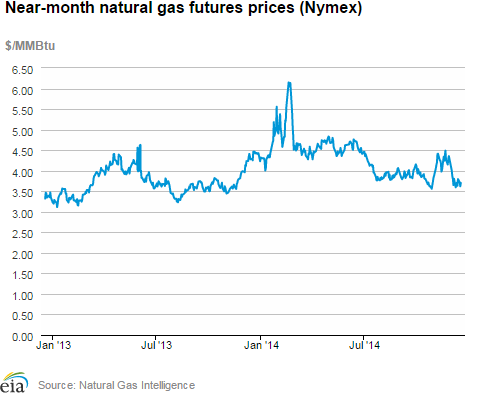
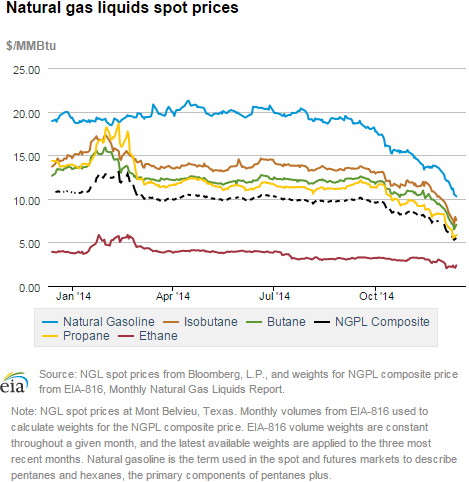
| U.S. Natural Gas Supply - Gas Week: (12/10/14 - 12/17/14) | ||
|---|---|---|
Percent change for week compared with: |
||
last year |
last week |
|
| Gross Production | 12.40%
|
0.14%
|
| Dry Production | 12.29%
|
0.13%
|
| Canadian Imports | -16.27%
|
-1.67%
|
| West (Net) | -1.89%
|
4.58%
|
| MidWest (Net) | -27.99%
|
-10.98%
|
| Northeast (Net) | -29.75%
|
-3.27%
|
| LNG Imports | -58.55%
|
-35.90%
|
| Total Supply | 9.39%
|
-0.05%
|
| Source: BENTEK Energy LLC | ||
| U.S. Consumption - Gas Week: (12/10/14 - 12/17/14) | ||
|---|---|---|
Percent change for week compared with: |
||
last year |
last week |
|
| U.S. Consumption | -20.7%
|
-0.6%
|
| Power | -15.5%
|
-1.9%
|
| Industrial | -4.3%
|
-1.0%
|
| Residential/Commercial | -30.2%
|
0.3%
|
| Total Demand | -20.2%
|
-0.9%
|
| Source: BENTEK Energy LLC | ||
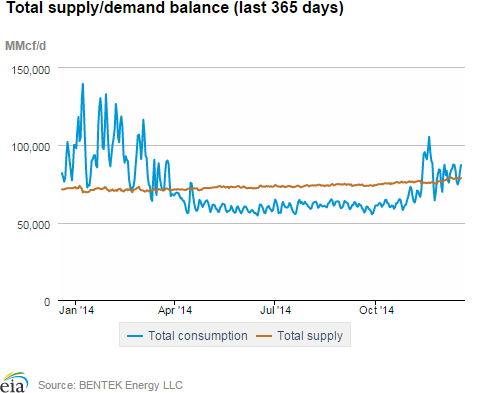
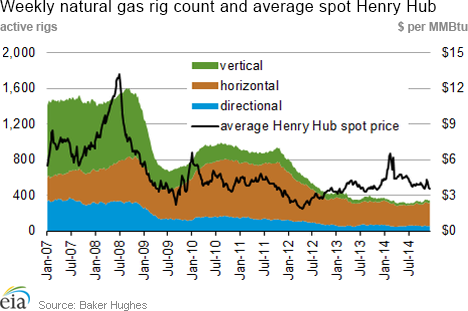
| Rigs | |||
|---|---|---|---|
Fri, December 12, 2014 |
Change from |
||
last week |
last year |
||
| Oil Rigs | 1,546 |
-1.84% |
9.57% |
| Natural Gas Rigs | 346 |
0.58% |
-6.23% |
| Miscellaneous | 1 |
0.00% |
-50.00% |
| Rig Numbers by Type | |||
|---|---|---|---|
Fri, December 12, 2014 |
Change from |
||
last week |
last year |
||
| Vertical | 330 |
-6.78% |
-18.92% |
| Horizontal | 1,367 |
-0.07% |
19.39% |
| Directional | 196 |
-1.01% |
-14.78% |
| Source: Baker Hughes Inc. | |||
| Working Gas in Underground Storage | ||||
|---|---|---|---|---|
Stocks billion cubic feet (bcf) |
||||
| Region | 2014-12-12 |
2014-12-05 |
change |
|
| East | 1,725 |
1,780 |
-55 |
|
| West | 471 |
470 |
1 |
|
| Producing | 1,099 |
1,109 |
-10 |
|
| Total | 3,295 |
3,359 |
-64 |
|
| Source: U.S. Energy Information Administration | ||||
| Working Gas in Underground Storage | |||||
|---|---|---|---|---|---|
Historical Comparisons |
|||||
Year ago (12/12/13) |
5-year average (2009-2013) |
||||
| Region | Stocks (Bcf) |
% change |
Stocks (Bcf) |
% change |
|
| East | 1,702 |
1.4 |
1,887 |
-8.6 |
|
| West | 458 |
2.8 |
484 |
-2.7 |
|
| Producing | 1,129 |
-2.7 |
1,182 |
-7.0 |
|
| Total | 3,289 |
0.2 |
3,553 |
-7.3 |
|
| Source: U.S. Energy Information Administration | |||||
| Temperature -- Heating & Cooling Degree Days (week ending Dec 11) | ||||||||
|---|---|---|---|---|---|---|---|---|
HDD deviation from: |
CDD deviation from: |
|||||||
| Region | HDD Current |
normal |
last year |
CDD Current |
normal |
last year |
||
| New England | 222
|
3
|
5
|
0
|
0
|
0
|
||
| Middle Atlantic | 220
|
12
|
5
|
0
|
0
|
0
|
||
| E N Central | 226
|
-13
|
-77
|
0
|
0
|
0
|
||
| W N Central | 232
|
-33
|
-158
|
0
|
0
|
0
|
||
| South Atlantic | 146
|
0
|
22
|
6
|
-2
|
-13
|
||
| E S Central | 132
|
-18
|
-32
|
0
|
-1
|
-2
|
||
| W S Central | 77
|
-34
|
-122
|
5
|
2
|
4
|
||
| Mountain | 147
|
-71
|
-174
|
0
|
0
|
0
|
||
| Pacific | 61
|
-54
|
-120
|
0
|
-1
|
0
|
||
| United States | 164
|
-23
|
-76
|
2
|
0
|
-2
|
||
|
Note: HDD = heating degree-day; CDD = cooling degree-day Source: National Oceanic and Atmospheric Administration | ||||||||
Average temperature (°F)
7-Day Mean ending Dec 11, 2014
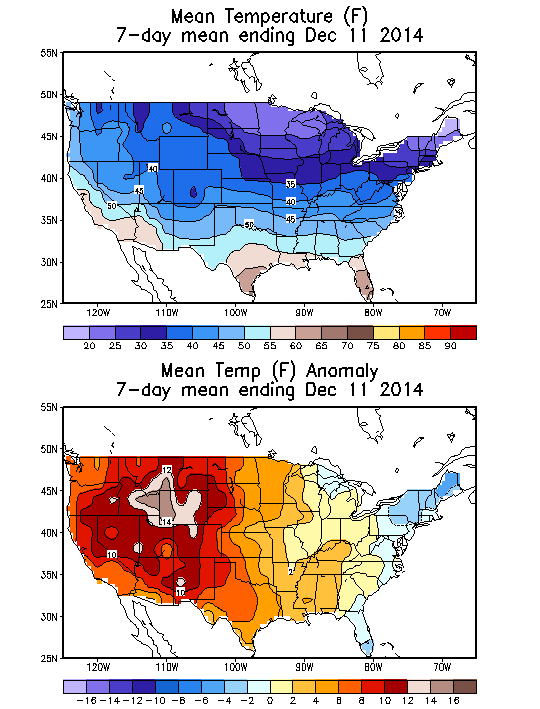
Source: NOAA/National Weather Service
Deviation between average and normal (°F)
7-Day Mean ending Dec 11, 2014

Source: NOAA/National Weather Service

